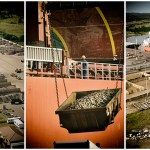LOOKING AHEAD
A tiny green shoot emerges, with SA set to buck global trend of decelerating growth

SA looks set to buck one worldwide economic trend in 2024, and for a change it’s sort of positive: The country’s economic growth is expected to accelerate.
The World Bank forecasts that global economic growth will slow in 2024, for the third year running. However, South African economic growth is seen as going against the wider grain and accelerating this year — despite political uncertainty in an election year, the power supply crisis and a flailing logistics industry.
That’s the good news. But this greenish shoot is emerging from a desolate landscape and South Africa’s forecast growth is hardly enough to put a meaningful dent into the country’s big three social challenges: poverty, unemployment and inequality.
To wit, the World Bank forecasts that South Africa’s economy will grow by 1.3% this year after an estimated expansion of 0.7% in 2023, while global economic growth is seen as braking further.
“Global growth is expected to slow for a third year in a row — to 2.4% — before ticking up to 2.7% in 2025,” the Washington-based lender says in its Global Economic Prospects report published earlier this month.
So, although South African economic growth is seen as picking up in 2024, at 1.3% it will still be only about half of the forecast slower global average.
It gets even worse if one looks at the forecasts for emerging and developing economies, which are forecast to grow by 3.9% in 2024, a notch below the 2023 estimate of 4%. The real drag on the global economy this year is the sour state of advanced economies, which are predicted to have a combined growth of only 1.2%.
On the regional stage, growth in sub-Saharan Africa is predicted to accelerate to 3.8% this year from an estimated 2.9% in 2023.
South Africa is a laggard on all these fronts bar advanced economies, and its very subdued forecast growth spurt is off a low base, as the economy may have tipped into a recession in the fourth quarter (Q4) of 2023 after contracting by 0.2% in Q3.
External forces, it seems, will provide little support this year for South Africa’s open economy, which is still heavily reliant on commodity exports.
On the bright side, the World Bank notes, “Global inflation is being tamed without tipping the world into a recession. It is rare for countries to bring inflation rates down without triggering a downturn, but this time a ‘soft landing’ seems increasingly possible.”
But then it strikes this chord: “Yet beyond the next two years, the outlook is dark. The end of 2024 will mark the halfway point of what was expected to be a transformative decade for development — when extreme poverty was to be extinguished, when major communicable diseases were to be eradicated, and when greenhouse gas emissions were to be cut nearly in half.
“What looms instead is a wretched milestone: the weakest global growth performance of any half-decade since the 1990s, with people in one out of every four developing economies poorer than they were before the pandemic.”
Domestic growth prospects
Alexforbes chief economist Mpho Molopyane adds that domestic growth prospects look promising, with improving self-generation electrical capacity, easing load shedding intensity and continued recovery in investment expected to lift growth to 1.2% in 2024 from an estimated 0.6% in 2023. Additionally, household consumption will benefit from the continued decline in inflation and lower interest rates, further boosting overall growth.
Annual consumer price inflation pulled back in December, easing to 5.1% from 5.5% in November and 5.9% in October. The South African Reserve Bank this week said it was holding steady on its GDP growth forecast of 1.2% and 1.3% for 2024 and 2025, respectively.
Sanisha Packirisamy, an economist at Momentum Investments, says she is expecting a shallow recovery in growth to 1% for 2024 and 1.7% in 2025.
“The improvement will largely be driven by further investment in the energy sector, lower average levels of load shedding, slightly more support for the consumer via lower inflation — higher real wages — and a lower interest rate environment. Growth will nevertheless still be hampered by logistics constraints.”
Senior economist Xhanti Payi forecasts growth of 0.9% this year, saying this is lower than his forecast of 1.2% last year on the back of several constraints including logistical challenges, continued energy constraints, tight monetary policy and constrained government spending at local and national government level, given fiscal constraints.
The roots of growth
On a more optimistic note, Old Mutual Wealth chief investment strategist Izak Odendaal says economic growth of about 2% this year will be a good outcome, especially given that it probably grew by less than 1% in 2023. (Final numbers are only expected in March.)
“The two main reasons for a more optimistic outlook is that lower inflation implies a rise in real incomes for households, which in turn means real household spending can improve between 1% and 2%. The other main reason is continued growth in private investment, particularly in electricity self-generation,” he says.
Where will the growth come from?
When it came to which sectors could potentially shift growth in the right direction, economists appeared to be somewhat divided. Some suggested agriculture while others highlighted its challenges — and the same for the construction sector.
According to the SA Reserve Bank’s data on operating surplus (part of the GDP breakdown), most sectors fared well in terms of profitability relative to longer-term average levels, barring the mining and manufacturing sectors, which were hit by lower commodity prices and severe load shedding.
This sentiment was corroborated by the South African Revenue Service’s corporate tax revenue data outside the mining sector. Growth in the SA Reserve Bank’s lead indicator points to a marginal improvement in growth for this year.
Packirisamy says although additional spending on alternative forms of energy and logistics (for example, on road rather than rail) could still raise business costs, a marginally brighter economic outlook should raise topline growth for firms.
Odendaal agrees. “The investment in electricity means less interruption to operations and sales, which should support the top line. However, the cost of alternative power supplies can be substantial, and therefore eat away at the bottom line. For solar, the costs are largely upfront, while for diesel generators it is ongoing,” he says.
Packirisamy believes that the much-needed growth could come from the agriculture and financial services sectors.
“Agricultural exports boomed last year and are set to continue given the investment in that industry. In general, the goods-producing sectors in SA have moved sideways since the pandemic, while growth has been more evident in the services-related industries, including financial services,” she says.
However, Thanda Sithole, senior economist at FNB, counters this by pointing out that the “volatile agriculture sector faces several challenges, including heightened input costs, biosecurity issues and adverse weather patterns exacerbated by climate change”.
Provincial contributions
When it comes to provincial contributions, in the third quarter of last year Stats SA released provincial GDP numbers for the first time in two years. The statistics based on 2022 numbers show that Gauteng remains the largest provincial contributor, despite being the smallest province. In 2022, the province was responsible for R33 of every R100 produced by the South African economy.
Finance, real estate and business services was the largest industry in the Western Cape, contributing 30% to value added in 2022. It was also the most influential industry in two other provinces — Free State and Gauteng.
Manufacturing was an important player (appearing in the top four) in the Western Cape, Eastern Cape, KwaZulu-Natal, Gauteng and Mpumalanga. These five provinces employed 90% of the national manufacturing workforce in 2021.
Political uncertainty
Molopyane says 2024 looks set to be a year of two halves in South Africa. The first half is likely to be dominated by campaigning ahead of the national elections, whereas the second half will be dominated by global developments as risk sentiment towards emerging markets is expected to turn positive.
“While opinion polls currently show the ANC losing an outright majority over employment, corruption and load shedding concerns, it is still too early to call the 2024 election results,” Molopyane says.
Overall political uncertainty has dampened economic growth prospects. According to the Bureau for Economic Research’s Manufacturing Survey, the biggest constraint to new investment is the political climate. In an election year, Parliament is generally tied up with election processes and political jockeying. As a result, Packirisamy observes, movement on policy decisions could be slower.
Odendaal has a different viewpoint.
“Businesses have enough to worry about operationally (electricity, logistics, crime) and are probably not paying too much attention to politics. However, I do think that many investors in financial markets are likely to take a wait-and-see approach before making firm decisions,” he told Daily Maverick.
“This is probably the consensus view by now — the ANC will retain power either on its own (narrowly) or with the help of a small centrist coalition partner. This implies broad policy continuity, for better or worse, in 2024. The big risk to markets and business sentiment overall is that the ANC’s support drops to around 40% and it is forced into a coalition with leftist or business-unfriendly parties.”
Unemployment
Will the growth be enough to shift unemployment numbers?
SA’s unemployment rate remains structurally high, rising from about 20% in 1994 to an average of 33.5% in the first nine months up to September 2023. Before the 2007-09 global financial crisis, the official unemployment rate decreased from 28.9% in 2003 to 22.3% in 2007.
However, Sithole notes that because of the impact of the crisis, the unemployment rate steadily increased, exacerbated recently by the profound impact of the Covid-19 pandemic.
“Achieving a significant improvement in unemployment would require robust economic growth. According to the National Development Plan, the economy would have to grow by a sustained approximate 5.4%. This will necessitate persistent, concrete policy support, primarily targeted at labour-intensive industries such as the primary and secondary sectors,” he says.
This sentiment was echoed by Packirisamy, who said a shift in unemployment numbers would require sustainable growth in labour-intensive sectors, such as tourism, agriculture and agro-processing.
“You would also need increased coordination between business, labour, government and the academic industries. This could include, for example, reopening vocational training institutions [and] matching tertiary education graduates to available job openings where there are shortages,” she says.
Odendaal says unemployment should start declining from its current very high levels if we see GDP growth of 2%.
“However, to make a meaningful dent in unemployment — getting the unemployment rate below 20%, for instance — will require sustained rates of growth above 3%, even more.
“Also, remember that some sectors are much more labour-intensive than others. Trade, construction and agriculture stand out as the … most labour-intensive industries (as measured by their share of GDP vs their share of total employment).
“Meanwhile, the biggest sector in the economy and the one that has posted the most consistent growth rates over time — financial and business services — is not labour-intensive, particularly not for unskilled labour,” he adds.
However, Payi says SA would need real GDP growth of at least 2.5% to reduce the unemployment rate. “As the economy changes, each unit of growth comes from [fewer and fewer] jobs. This, in fact, has been the case in the last decade,” he says.
Impediments to growth
Packirisamy cautions that, outside of investment in the energy sector, the construction industry could potentially drag numbers down, given the overhang in supply of residential and non-residential property. Moreover, “high labour costs, high electricity costs, high municipal charges and reasonably pedestrian demand prospects continue to dampen activity in the manufacturing space”, she explains.
Beyond industry sectors, Odendaal points out that the flip side of the necessary fiscal consolidation — reducing the budget deficit — is that government spending is likely to be a drag on overall activity.
“The intention from Treasury’s side is still to shift the composition of spending away from consumption (salaries, goods and services) towards capex. This again bodes well for construction, but could drag on trade sectors,” he warns.
Rather than singling out sectors, Odendaal believes the growth is likely to be “a fairly broad-based improvement across industry sectors as the impact of load shedding eases somewhat and the backlogs at the ports are addressed.
“It’s worth noting, however, that some sectors have much more room to recover than others. The GDP level of the construction sector, for example, remains more than 20% below pre-Covid levels,” he says. DM
This story first appeared in our weekly Daily Maverick 168 newspaper, which is available countrywide for R29.




















In Nirvana perhaps